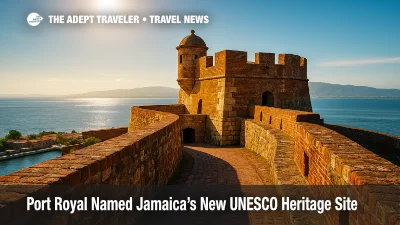Port Royal Named Jamaica's New UNESCO World Heritage Site

Port Royal, the once-buccaneering town guarding the mouth of Kingston Harbour, is now officially a UNESCO World Heritage Site. The World Heritage Committee added the Archaeological Ensemble of 17th-Century Port Royal to the prestigious list on July 12, 2025, recognising the submerged and terrestrial ruins for their "outstanding universal value." The decision gives Jamaica its second entry on the list, joining the Blue and John Crow Mountains. Officials say the honour will preserve the town's unique colonial history while boosting heritage-focused tourism across the island. Conservation work is already under way to protect fragile underwater artefacts and interpret the site for visitors.
Key Points
- Why it matters: Port Royal gains global legal protection and fresh tourism appeal.
- Second UNESCO site for Jamaica after the Blue and John Crow Mountains (2015).
- Site covers 27 hectares on land and under water, with a 292-hectare buffer zone.
- 1692 earthquake sank much of the town, leaving a rare "sunken city" to explore.
- Heritage status expected to channel funding into conservation and community projects.
Snapshot
Port Royal flourished between 1655 and 1692 as England's pivotal Caribbean port, infamous for privateers and the transatlantic slave trade. In four decades it became one of the wealthiest settlements in the Western Hemisphere, only to be devastated when a magnitude-7.5 earthquake sent two-thirds of the town sliding into the sea. Today, visitors can stroll Fort Charles, dive the submerged streets, and view artefacts that capture daily life in the 17th century. UNESCO's inscription secures international backing for safeguarding the fragile wreckage while encouraging carefully managed tourism that benefits local residents.
Background
Jamaica nominated Port Royal under criteria (iv) and (vi), citing its unparalleled archaeological record of an early-modern colonial port frozen in time by disaster. The listing follows a decade-long technical process involving marine surveys, conservation planning, and stakeholder consultations led by Jamaica's National Heritage Trust and the Ministry of Culture. The Blue and John Crow Mountains, inscribed in 2015 for their ecological and Maroon cultural heritage, set a precedent for Jamaica's commitment to World Heritage stewardship. Together, the two sites showcase the island's diverse stories-from freedom seekers in rugged forests to merchants and enslaved Africans in a bustling harbour town.
Latest Developments
Tourism plans move forward
Kingston Port Authority, the Ministry of Tourism, and community leaders are drafting a heritage-tourism master plan that balances visitor access with site preservation. Proposals include a dedicated interpretive centre near Fort Charles, controlled dive tours of the sunken streets, and training programmes to certify local guides in maritime archaeology. Officials project a 10-15 percent rise in cultural visitor arrivals within three years, with heritage tourism spending funnelling into small businesses in Port Royal and adjacent communities. Environmental safeguards-such as no-anchor zones and visitor caps-are written into the plan to prevent damage to underwater ruins and fragile coral habitats.
Analysis
UNESCO listing often triggers a surge in visitor interest: Dubrovnik saw arrivals double after 1979, while Machu Picchu's foot traffic quadrupled within a decade of its 1983 inscription. Port Royal's situation is more complex. Unlike hilltop citadels or walled cities, much of its heritage lies under water, demanding costly conservation and specialist visitor infrastructure. The challenge is to convert curiosity into sustainable economic gain without repeating mass-tourism pitfalls.
Jamaica faces three priorities. First, invest in robust site management-both topside and underwater-to avoid artefact looting and anchor damage. Second, diversify visitor flows beyond cruise-heavy Kingston to spread income across the parish. Third, engage residents through training and micro-enterprise grants so local stories shape the tourist experience. Success could position Jamaica as a leader in maritime-archaeological tourism, a niche with high spending potential and lower volume pressure. Failure, however, risks corrosion of priceless artefacts and community resentment. The government's early emphasis on inclusive planning and environmental limits is encouraging, yet long-term funding and enforcement will be critical.
Final Thoughts
UNESCO status is not an end but a beginning. Port Royal now enjoys the world's gaze and, crucially, its protection frameworks. If Jamaica couples rigorous conservation with community-led tourism, the "sunken city" can rise again-not as a pirate haven, but as a living classroom of Caribbean history. Responsible travellers will find a destination where archaeology, legend, and resilient culture converge, reaffirming the global value of the Port Royal UNESCO World Heritage Site.
